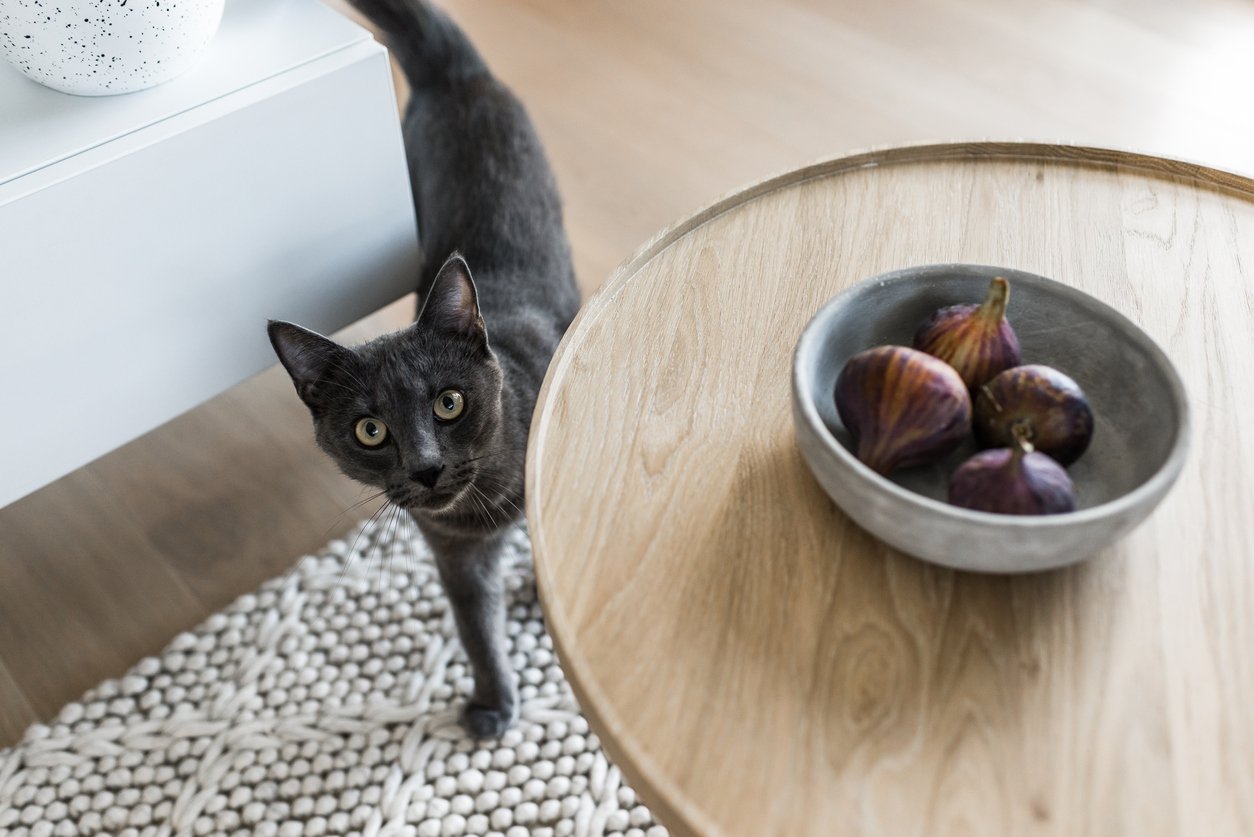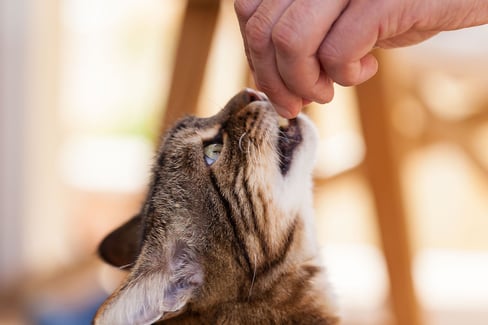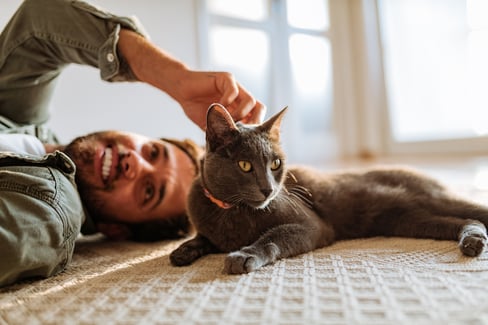Table of Contents
If you look online, there are tons of articles about the dangers of your cat being overweight or obese, like the development of heart disease, diabetes, and joint issues, but an underweight cat is arguably just as dangerous for overall cat health.
While some dogs can reach over 100 lbs in weight, cats don’t usually weigh that much because they are much smaller than most dogs.
In general:
- The majority of domestic cats should weigh about 10 lbs (4–4.5 kgs), give or take a pound or two.
- Larger cat breeds, like Maine Coons and Savannah Cats, will naturally weigh more, typically between 10–18lbs (4–8 kgs)
With that being said, it’s not uncommon for some cats to weigh as much as 25lbs or as little as 5lbs (2.2kgs).
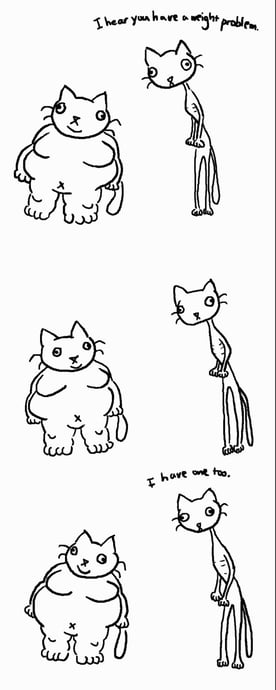
As you can see, there can be vast variations for the ideal weight of a cat—so there isn’t one ideal number that indicates your cat is overweight or underweight. That can be a problem when you’re trying to figure out if your kitty is at a healthy weight.
Thankfully, there are physical signs that you can use—besides the scale—to determine whether you have an underweight cat or not.
What Is Underweight for a Cat?
The scale alone often isn’t enough to determine what is underweight for a cat. While most domestic cats are on average about 10lbs (4–4.5kgs) there is lots of potential variation depending on breed, sex, and genetics. For instance, tomcats (male cats) are generally larger in stature and heavier compared to females. A tomcat is usually heavier than a female (queen) due to their more muscular build and heavier bone structure. Muscles and bones weigh much more than fat, so the fact that a male cat is heavier than a female isn’t surprising.
Given that a weight measurement alone doesn’t tell the entire story with regard to whether a cat is underweight, there is another method that you can use to determine whether you have an underweight cat or not. This method is called the body condition score (BCS).
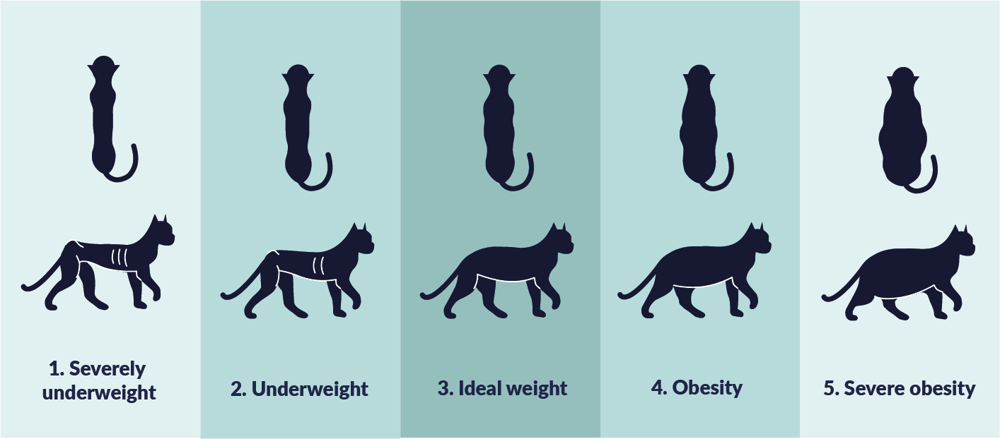
While humans typically use BMI (body mass index) as a general measure of ideal body weight, the body condition score is used for animals, including cats, dogs, and horses to determine whether they are underweight or overweight. The BCS is a quantitative measure (provides a number) but also a somewhat subjective way to evaluate the amount of body fat your kitty has.
The BCS also considers that there is natural variation in cats depending on their breed and sex, so it focuses entirely on how your pet’s body looks and feels rather than its size or stature. There are two types of body condition scoring systems (either a 1–9 scoring system or a 1–5 scoring system) and it seems to be a personal preference of veterinarians for which one to use. Both are legitimate, however, and can be used to determine what is underweight for a cat.
The main difference between the 1–5 BCS scale and the 1–9 BCS scale is the detail of the scoring system. As you can imagine, the 1–9 scoring system has a bit more detail in the scores, as indicated in the table below:
|
BCS 5-Point Scale |
BCS 9-Point Scale |
|
|
While a visual and table are helpful, there are more details regarding how you can tell the BCS of your cat.
- If you have a very underweight cat, its ribs can be easily seen with minimal fat cover. With very underweight cats, you will also easily be able to see and feel their lumbar vertebrae (spine) and pelvic bones.
- Underweight cats will still have obvious lumbar vertebrae that you can easily see or feel, but you may only be able to see their ribs if they are a shorthair kitty. In general, ribs will be easy to feel, and there will be an obvious waist behind their ribs. On their abdomen (closer to their back legs) there will be minimal fat pads.
- Cats at an ideal weight will appear well-proportioned. You will likely still be able to feel their ribs, but they won’t be as prominent because they will have a slight fat covering. You should still be able to see your kitty’s waist, but it won’t be as pronounced in that it will naturally flow to their backside, where abdominal fat pads will be present, but minimal.
- Overweight cats have slight excess fat covering their rib cage, and their waist and abdominal fat pads will be present, but not very obvious. This means that looking at an overweight kitty, you will likely not be able to immediately tell where their waist is without touching them.
- Obese cats will have ribs that can’t be easily felt because there is too much fat covering them. Because of excess fat covering, their waist will also be absent, and they will have a prominent abdominal fat pad. There will also be fat deposits around their lower back area.
- Severely obese cats have heavy fat cover, and identifying the ribs will be difficult. Their waist will also be non-existent, and they’ll have heavy fat deposits on their abdomen, lower back, face, and limbs.
Aside from the body condition score, there are other signs that you can keep in mind to determine if your kitty is at risk of becoming underweight. These signs include lack of appetite, change in food preference, and—believe it or not—lethargy.
Lack of Appetite
It might seem obvious that if your cat isn’t eating, it will lose weight. But if you free-feed your cat dry kibble and don’t pay attention to the level of the food bowl, or you see your cat eat a couple of kibbles as you’re passing them by, it’s easy to think that maybe they’re just not hungry—until that lack of appetite starts to show through weight loss. Some cats are extremely picky about their food, so it’s not too uncommon for a cat to seemingly suddenly stop wanting to eat.
The sudden aversion to their once favorite food could be a result of many different factors:
- Whisker fatigue is when your cat’s whiskers brush up against their food bowl, sending too many signals to their brain, which becomes overwhelming. Your cat’s whiskers give them information about their surroundings—like whether they can squeeze into tight spaces—and help them detect air currents. When your kitty’s whiskers are stimulated too much while they are eating, this overwhelming sensation can be uncomfortable and cause them to avoid the food bowl. Giving them a wide bowl that’s raised to about the level of their head is a great way to prevent whisker fatigue.
- Stale or old food isn’t very appetizing to your kitty. Imagine if you were offered stale crackers or cereal—you wouldn’t want to eat it either! If you feed your cat dry kibble, don’t fill the entire bowl up at once—give them smaller portions to eat instead throughout the day so that the food stays fresh. With wet food, it’s a general rule that portions should not be left out for more than 1–2 hours.
- Illness could be another reason why your cat doesn’t want to chow down on their food. Check their litter box for signs of diarrhea or a urinary tract infection (they will either pee much more than usual or have blood in their urine). Throwing up a lot is another indicator that your cat may be suffering from something and needs a trip to the vet.
Change in Food Preference
If you ate the same thing for every single meal every single day, you’d get bored of eating. The same goes for your kitty. Feeding them the same dry kibble day in and day out isn’t exactly encouraging them to eat. While it isn’t recommended to switch your cat’s food from one type to another in one day because they may get sick, you can gradually change your cat’s food over the course of a week by mixing in more and more of the new food with the old stuff daily.
Some owners may also be wanting to change their cat’s food from dry kibble to wet food or raw cat food. Just like changing over kibble, new foods should be introduced to your cat slowly so as not to upset its digestive system.
Lethargy
Another important reason why your cat may not be willing to eat is because they simply do not have the energy or desire to walk over to their food bowl. Cats can sleep up to 20 hours a day, but if they can’t even be bothered to eat, they are likely suffering from an illness that needs to be investigated by a veterinarian. If your cat doesn’t eat within 24–36 hours, their liver and kidney disease risk increases.
Why Is My Cat Underweight?
Sometimes, you can watch your cat closely, and they still become underweight. If your cat is already small, even losing one or two pounds is cause for concern. For example, if your cat only weighs 6 lbs (about 3 kg) and loses just over half a pound (total weight 5.4 lbs, or 2.7kgs), that’s a 10% loss of body weight, which is significant. It’s less of a problem if your cat is heavier, but ideally, you want to reduce any weight fluctuations as much as possible.
Potential Causes of Severely Underweight Cat
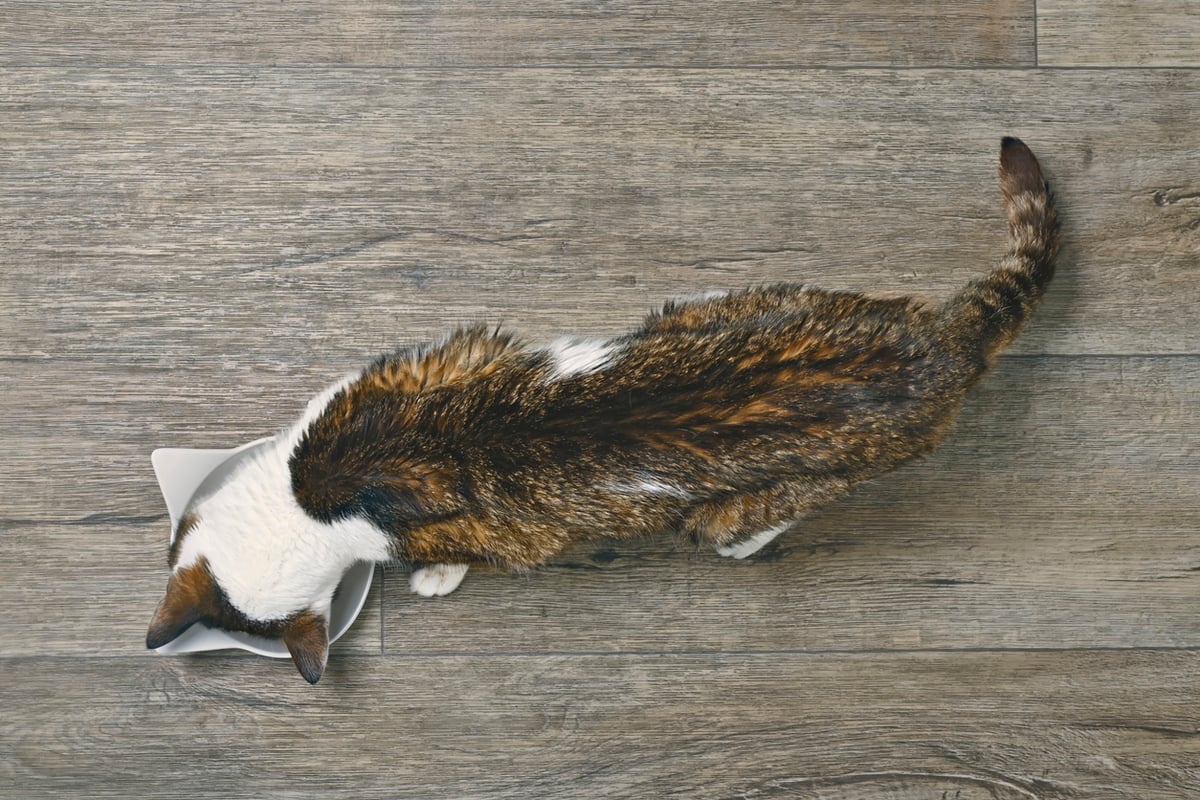
If you currently have an underweight cat, there are a variety of reasons why your cat may have seemingly suddenly lost weight aside from just not consuming enough food.
1. Hyperthyroidism
Hyperthyroidism in cats is similar to humans—the thyroid gland overproduces thyroid hormones, which leads to an increased heart rate, higher blood pressure, and negative effects on all of your kitty’s organs, especially their kidneys, liver, and heart. In cats, hyperthyroidism can be tricky to spot because they are losing weight despite the fact that their appetite is fine.
Common signs that your kitty might have hyperthyroidism besides the increased appetite and weight loss include:
- Vomiting and diarrhea
- Drinking and urinating more than usual
- Increased grooming, but their coat appears unkempt anyway
- Hyperactivity
- Increased meowing
To diagnose hyperthyroidism, your veterinarian will perform a blood test to check your kitty’s thyroid hormone levels. While in the past, there wasn’t a treatment for hyperthyroidism, there is now an FDA and Health Canada-approved medication to treat the condition—methimazole. This medication is typically given to your cat in liquid or pill form. There is also an ointment version that can be applied to the inside of your cat’s ears as well as a hyperthyroidism food, but these methods are often considered less effective compared to liquid or pill medication.
2. Gastrointestinal Blockage
When your cat’s digestive tract is blocked, it affects the passage of fluid and foods and can damage digestive tissues. As you can imagine, an obstruction in the digestive system can be a serious medical condition for your cat.
Gastrointestinal blockage in cats can be caused by a number of issues, such as tumours, foreign objects, polyps (a small clump of cells that form on the lining of the colon), and stomach tissue overgrowth. The obstruction can be partial or complete.
Cats are notorious for ingesting small objects like string and fabric. Foreign objects can cause intussusception (a segment folds into another segment—like folding a telescope) and incarceration (a section of the intestine becomes trapped or blocked—like with a hernia). Long pieces of string, yarn, or fabric may become attached at the base of the tongue and travel into the intestines, resulting in intestinal perforation (a cut in the intestinal wall) due to the sawing movement of normal intestinal function.
Signs of gastric or small-intestinal obstruction often include:
- Vomiting
- Loss of appetite
- Lethargy
- Abdominal pain or swelling
- Fever
- Dehydration
- Shock
To diagnose a gastrointestinal blockage, your vet will perform a physical exam to determine if they can feel enlarged organs, thickened bowel loops, and gas. They may also perform X-rays to detect the problem and use ultrasonography or an endoscope to determine the exact location of the problem.
3. Kidney Disease
Weight loss and increased thirst and urination are common renal (kidney) disease symptoms in cats. When kidney disease has progressed to a severe level, your cat will also become extremely lethargic due to the organ’s inability to remove the by-products of protein metabolism and certain minerals like phosphorus from the blood. Instead, these by-products build up in your kitty’s bloodstream, causing them to feel weak and lethargic.
Other common signs that your cat may have kidney disease include:
- Nausea and vomiting
- Poor appetite (often due to nausea)
- Anemia (when the body does not have enough healthy red blood cells)
- General signs of weakness (incoordination, pale gums, etc.)
To diagnose kidney disease, your vet must perform a blood test to check the levels of creatinine and BUN (nitrogen levels) in your cat’s blood. High levels of these proteins are indicators of kidney disease. Your vet may also perform a urine test to determine the kidney’s ability to concentrate urine and detect possible infection, blood, and protein loss.
Various treatments may be used for feline kidney disease, such as intravenous fluids to correct dehydration, supplements, and medications. A carefully managed diet with plenty of fresh water is also essential.
4. Diabetes
When a cat has diabetes, it means that the body cannot properly produce or respond to insulin, a hormone that controls the levels of glucose in the blood. There are three main forms of diabetes in cats:
|
Diabetes Type |
Description |
|
Type 1 |
Near destruction of the cells that produce insulin results in a high concentration of glucose levels in the blood. Type 1 diabetes is quite rare in cats. |
|
Type 2 |
Some insulin-producing cells are present, but the amount of insulin produced is insufficient to sustain healthy levels of blood glucose. Type 2 can also describe a delayed response to high blood glucose levels in your cat’s body or that the tissues in your cat’s body are insulin-resistant. Obesity is a significant factor in developing Type 2, and given the high number of obese cats, Type 2 is the most common form of feline diabetes. |
|
Type 3 |
Insulin resistance is caused by other hormones in your cat’s body, sometimes due to pregnancy or hormone-secreting tumours. |
The typical signs of diabetes in cats, regardless of the type, usually include:
- Excess thirst
- Excess urination
- Increased appetite and weight loss (your cat’s body will break down fats and proteins in an effort to feed glucose-starved cells, resulting in weight loss despite eating more)
To diagnose diabetes in your cat, your vet will perform blood and urine tests. Because the kidneys do not filter glucose out of the blood and into the urine unless an excessive glucose level is present in the blood, the urine of a diabetes-afflicted cat will have glucose in it. To confirm the diagnosis, your vet may also perform a serum fructosamine test, which measures the average blood glucose levels over a week to two weeks.
Treatment of the condition usually involves regular insulin injections.
Consequences of an Underweight Cat
When your cat is underweight, it’s a sign that they are not getting the nutrition they need. When a cat’s body doesn’t get what it needs to function properly, serious health conditions can arise, which can potentially result in death if not treated.
When your cat is underweight, it’s usually a result of a pre-existing health condition like the ones mentioned in the previous section. Getting your cat checked out by a veterinarian to determine if they have any conditions that could be causing their weight loss is paramount. Often, treatment of the condition causing an underweight cat is enough to correct the issue.
An underweight cat can also experience joint issues due to a lack of nutrition. Consider incorporating TRI-ACTA into their diet to help maintain your cat’s joint health. With 100% active ingredients, the cat supplement won’t aggravate your cat’s digestive issues.
TRI-ACTA for Pets
A proactive approach for developing and younger adult pets to maintain optimal joint health mobility, minimize inflammation and fend off age-related ailments.
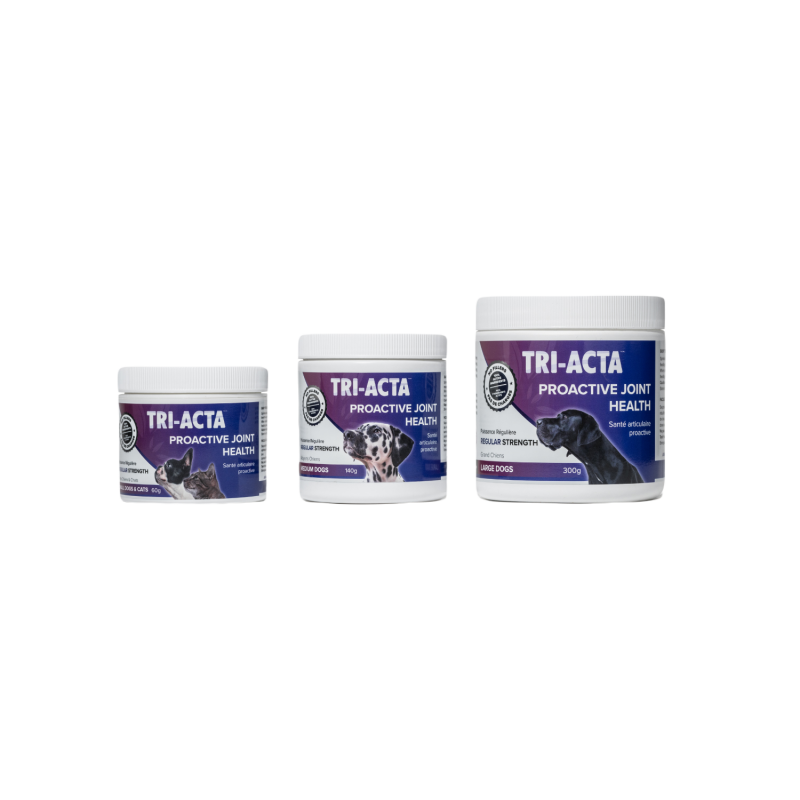
3 Care Steps for Cat Underweight
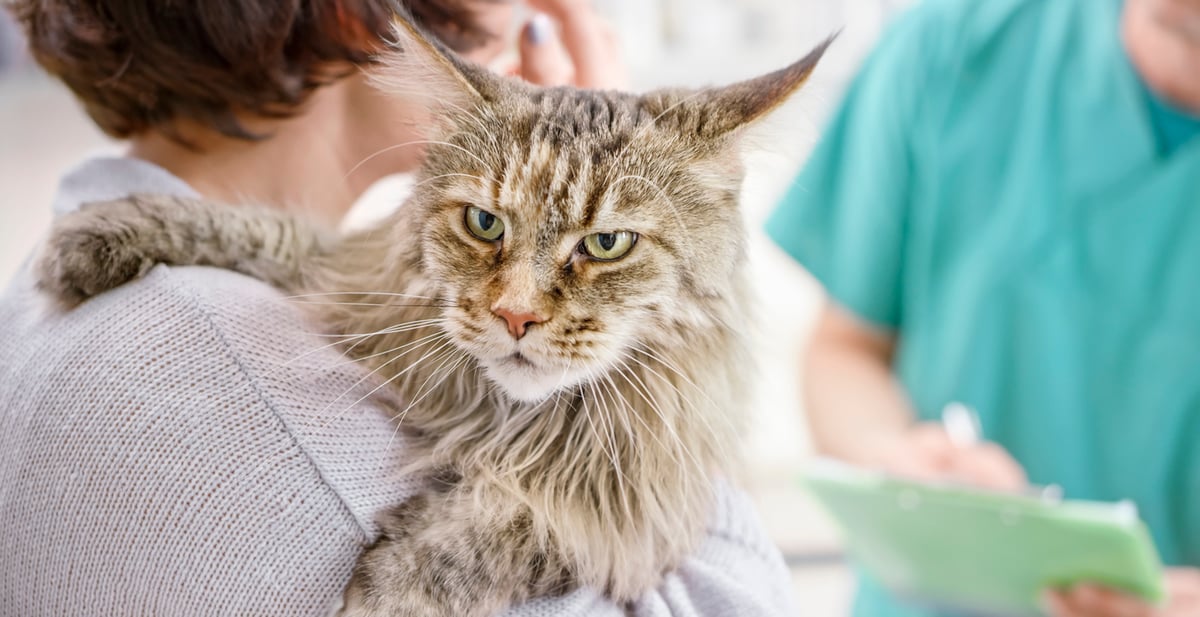
To help your cat gain weight safely and get them back up to a healthy body structure and function, there are several steps that you should take:
1. Getting Treatment for Any Underlying Health Conditions
If you don’t take your cat to the vet so they can investigate any potential underweight cat causes, then it doesn’t matter if you follow the next steps; your cat won’t get better. Conditions like hyperthyroidism, diabetes, gastrointestinal blockage, kidney disease, and more require treatment through medications or surgery before diet changes will positively affect your kitty.
2. Feeding Small, Frequent Meals
If your cat is severely malnourished, whether it be from a disease or simply from living on the streets and not having access to food (if you’ve rescued a cat), then the best way forward is to feed them many small meals throughout the day. If a cat is severely malnourished, feeding them large amounts of food quickly can cause a condition called refeeding syndrome.
When your cat’s body is in starvation mode, their body functions slow down in an effort to preserve their function. Carbohydrates stored in cells are used as the main source of energy instead of protein since their body isn’t getting food. This use of carbs for energy causes many electrolytes (phosphorus, potassium, and magnesium) to enter the bloodstream. If you feed your severely underweight cat too much food too quickly, it stimulates the release of insulin, which causes these electrolytes to move back into the cells as your cat’s body tries to adjust to suddenly having protein as a source of energy. This quick shift of electrolytes back into your cat’s cells can cause a dangerous drop in blood levels, resulting in various life-threatening conditions such as seizures, coma, and more.
3. Make Meals More Enticing
If a cat isn’t feeling their best, they may not have an appetite. Since your cat must eat, trying different techniques to make your cat’s food more palatable is sometimes required. A common method is warming food to increase the smell and whet their appetite. This can be done by putting wet food in a microwave-safe container and heating it in the microwave for a few seconds or by pouring warm water into dry food. Ensure the food's temperature isn’t too hot for your kitty to handle!
Cat Food Recommendations for Weight Gain
If you have an underweight cat on your hands, here are some recommendations that can help them get back up to a healthy weight:
1. Go! Solutions Sensitivities Limited Ingredient Wet Cat Food
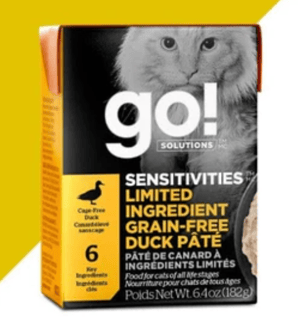
Underweight cats often have sensitive stomachs, whether due to insufficient nutrition or a disease or ailment. Go! Solutions has a sensitive wet food variety that uses only one type of animal protein (multiple animal proteins can be hard on a kitty’s tummy) and contains antioxidants that help with digestion and omega-3 fatty acids. Zero by-products and preservatives mean that your cat isn’t ingesting any additional undesirable ingredients that may hurt their sensitive digestive system.
$4.28 per carton. Price as of August 2023.
2. Royal Canin Hydrolyzed Protein Dry Cat Food
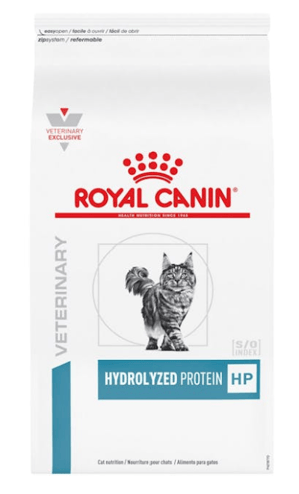
Cats with food allergies that cause them to have stomach issues, like diarrhea or vomiting, may benefit from a hydrolyzed protein food. With hydrolyzed protein, the proteins in the food have been broken down into smaller components using water and enzymes, making it easier for your cat to digest the food. The smaller protein fragments, as a result of the hydrolyzation process, are less likely to trigger gastrointestinal upset or an allergic reaction by your cat’s body.
Starts at $43.12 for a 1.5kg bag. Pricing as of August 2023.
Summary
There can be many causes of an underweight cat besides just not eating enough. Cats that are chronically underweight usually have underlying health issues that need to be addressed before they can be brought back up to a healthy weight.
Underweight cats that are not getting enough nutrition may see joint deterioration over time due to lack of nutrients. To ensure that your cat is maintaining their joint health, consider incorporating TRI-ACTA into their daily diet. With 100% active ingredients and no fillers, preservatives, or additives, TRI-ACTA will not aggravate any gastrointestinal issues that your kitty may have.
TRI-ACTA H.A. for Pets
Our maximum strength formula is optimally designed to accelerate the formation of cartilage, minimize inflammation, expedite the healing process, and improve joint conditions.

Purchase TRI-ACTA online today, or find out where to buy in a store near you.
Newsletter Signup
Subscribe to our newsletter to receive the latest news and exclusive offers.
.jpg?height=2000&name=Cliick_Integricare-DISPLAY-REVISEDV2%20(1).jpg)
Proactive & Therapeutic Joint Supplements
When given daily, Integricare joint supplements recover bone and joint injuries faster and help prevent mobility injuries from happening in the first place.

